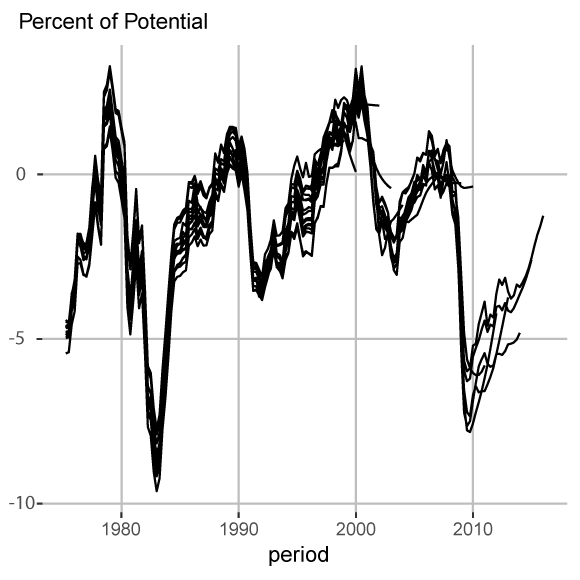FEDS Notes
October 15, 2019
Real-time Historical Estimates of the Output Gap
Luke Van Cleve, Jean-Philippe Laforte, and Andrea Stella1
The staff of the Board of Governors of the Federal Reserve System regularly produces estimates of the output gap for use in constructing the staff's official Tealbook economic forecasts, furnished eight times per year to assist members of the Federal Open Market Committee in their policy deliberations.2 The purpose of this note is to highlight the recent availability of an expanded set of historical data of the staff's estimates of the real-time output gap at the Real-Time Data Research Center of the Federal Reserve Bank of Philadelphia.3
Some history and projections of the estimates of the output gap are already reported for a large number of FOMC meetings in their corresponding material made public on the Board's website.4 However, the real-time historical samples provided (if any) are rather short, typically no more than a few years, making it impossible to perform time series analyses using the estimates. The newly released dataset addresses this issue by making available long historical samples (starting in 1975) of the output gap, in real-time, for all the vintages from the March 26, 1996 FOMC meeting to the December 17-18, 2013 FOMC meeting.5 It should be noted that the extended series in the new dataset were archived in electronic databases but not necessarily reported in the Greenbook/Tealbook, hence these data were not contemporaneously checked as carefully; as a result, they may contain small errors.
Figure 1 shows how the Greenbook estimate of the output gap changed over time from 1996 to 2013; each line represents the estimate produced for the December FOMC meeting in a specific year.
References
Edge, Rochelle M. and Jeremy B. Rudd, "Real-time properties of the Federal Reserve's output gap," The Review of Economics and Statistics, 2016, 98(4), 785-91
1. The views expressed in the article are those of the authors and do not necessarily reflect those of the Federal Reserve System. Return to text
2. The estimate of output gap is defined as the percent difference between actual and potential output. For all the vintages from 1996 to 2013, output stands for the BEA's estimate of gross domestic product (GDP). Return to text
3. The new data was posted at https://www.philadelphiafed.org/research-and-data/real-time-center/greenbook-data/gap-and-financial-data-set, and can be obtained by clicking on the "Output Gap" link. By rule, the projections from the Tealbook are released to the public with a lag of five years. Return to text
4. https://www.federalreserve.gov/monetarypolicy/fomc_historical_year.htm. The Federal Reserve Bank of Philadelphia conveniently provides an excel file with the available estimates of the output gap since 1987 at https://www.philadelphiafed.org/research-and-data/real-time-center/greenbook-data/gap-and-financial-data-set under the "Previous Output Gap" link. Return to text
5. Edge and Rudd (2016) have also made available longer historical samples of the real-time output gap estimates for selected vintages between 1996 and 2008. Compared to their study, the new data set provides vintages beyond 2008 and data for all the FOMC meetings rather than selecting a specific one for each calendar quarter. Return to text
Van Cleve, Luke, Jean-Philippe Laforte, and Andrea Stella (2019). "Real-time Historical Estimates of the Output Gap," FEDS Notes. Washington: Board of Governors of the Federal Reserve System, October 15, 2019, https://doi.org/10.17016/2380-7172.2460.
Disclaimer: FEDS Notes are articles in which Board staff offer their own views and present analysis on a range of topics in economics and finance. These articles are shorter and less technically oriented than FEDS Working Papers and IFDP papers.
